|
Departments
eBook now Available!
|
Exclusive - THE book on Traditional & Classic
Siamese cats
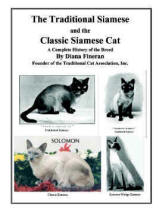
Written by the Founder of TCA, Inc.
Tullycrine
Affordable
Web Design
|
|
|
The Traditional Russian Blue © FAQs
Traditional Russian Blue Breeders
COPYRIGHT DIANA FINERAN FEBRUARY 8, 2001
|

|
Photos Courtesy of Sonny Hansson
Click on photo to enlarge |
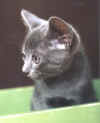
|
HISTORY
This very ancient breed has a long past with its actual date of origin being
unknown. From the mid-1800’s onward, when they became known to the world, the
Traditional Russian Blue has been known by many breed names, such as; Archangel
Blue, Archangel Cat, Spanish Blue, Maltese Blue, Blue Maltese, Maltese Cat,
Foreign Blue, Self-Blues, Short-haired Blues, and Canon Girdlestone’s (in
Norway).
As with most of the very ancient breeds there is considerable myth
surrounding the origin of the Russian Blue. The mists of time have given us a
bit of light on this puzzle. It is believed the Traditional Russian Blue is a
natural breed originating in the Archangel Isles in northern Russia only 150
miles south of the Arctic Circle. A legend tells that these gorgeous cats were
trapped for their plush double coats, which are sometimes compared to the coat
of a beaver or seal. Their thick coats give credence to the hypothesis that they
developed in a cold country, and according to some accounts, blue short hairs
still exist in Russia. Another rumor credits the Traditional Russian Blue as
being a descendant of the Royal Cat of the Russian Czars and as a favored pet of
Queen Victoria.
The most commonly held theory is that Traditional Russian Blues were brought
to Great Britain and northern Europe in 1860 by British sailors from the White
Sea Port town of Archangel (Arkhangelsk) in northern Russia. There are accounts
that blue short haired cats still exist in Russia. Due to their origins in a
very cold climate one of the main characteristics of the breed was its thick
double coat.
|
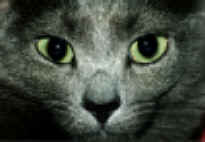
|
Photos Courtesy of
Sonny Hansson
Click on photo to enlarge |
A Traditional Russian Blue was shown at the first cat show in 1871 at the
Crystal palace in London, under the name, "Archangel Cat", in a class
for all short haired blue cats, despite obvious differences in type.
The first photograph I found through my research was in the 1900 book,
"Concerning Cats", by Helen M. Winslow. The caption reads, "Fine
specimen of a genuine Russian cat, owned by Mrs. Frederick Monroe, Riverside,
Illinois. Obviously they made it to the U.S. by 1900!
When the Traditional Russian Blue first came out of its native country it
differed strickingly from the Traditional Turkish Angora and the Traditional
Persian (Doll Face), who were the other long-haired breeds existent at the time,
by having a larger body and shorter legs. Their coat was long and dense, but of
a rather coarse texture, and the mane or frill over the shoulders was very
woolly. It was usually of tabby color, and had bright orange eyes, which were
often tinged with green. Their ears were larger too.
A good amount of early discussion is given by Francis Simpson in her 1902
book, "The Book of the Cat". "I propose to deal first with those
interesting short-haired self-colored cats formerly called Russian or Archangel,
and which in America are termed Maltese."
"there has been a good deal of discussion lately as to the points
desirable in these cats, which of recent years have clearly become a species of
British cats, and therefore are rightly classed as such at our shows, instead of
as Russians. Yet, this latter name sticks to the variety, and no doubt there are
still some real foreign short-haired blues to be found, differing, however, in
type from those we have become accustomed to breed and exhibit in England.
Harrison Weir and John Jennings, in their book on cats in the early days of the
fancy, deal with cats called Russians amongst the long-haired breeds, and these
are described by them as larger in body and shorter in leg than Persians, with a
coat of wooly texture interspersed with wiry, coarse hairs. In color we are told
they were generally dark tabby, the markings being rather indistinct. I do not
think such cats are to be found now in our midst, and so I presume this species
of long-haired cat has died out. Anyhow, the term "Russian", when now
used, is meant to designate the self-colored, smooth-haired cat with which we
are all familiar. Certainly the best blues I have always remarked are those that
have been bred in England, or that, at least, can boast an English sire or dam.
And after writing right and left to breeders of British cats, I have had a
difficulty in obtaining any really good photographs. I can not, however,
complain of the pictures of blue short-hairs, which illustrate these pages, and
which have been really showered upon me. I have failed, however, to be able to
illustrate the difference between the foreigners and Britishers."
"That there are two distinct types of these blue cats is apparent to
anyone who observes the specimens exhibited at our shows. The foreign or
imported variety have, wedge-shaped faces, and are longer and larger in the
head, with prominent ears. Otherwise, in color and coat, they are similar to
those bred in England, and which partake of the same formation as an ordinary
British cat. In describing the correct texture of coat of these short-haired
blues, I would compare it to plush, fore the hair does not lie softly on the
slope, but has a tendency to an upright growth, and yet the coat should not have
any suspicion of coarseness or roughness to the touch. We know the difference
between silk and cotton plush, and it is to the former I would liken the correct
coat of these blues. Needless to say that, as in all self-colored cats, the
colors should be absolutely even. Of a bluish, lilac tint, without any sootiness
or rusty shade. As in other breeds of "selfs", the young kittens
exhibit distinct tabby markings, but these vanish as the coat grows and many a
ringed tail, which may have caused distress to the breeder, will, as time goes
on, be proudly held aloft without a suspicion of any blemish. The blues now
exhibited appear generally to fail in eye, the color being yellow, and often
green or greenish-yellow. Whereas a special feature of this breed should be a
deep orange eye, round and full. Another fault, which is sometimes apparent, is
too thick a tail, which is suggestive of a long-haired ancestor. The following
is an interesting letter from Mrs. H.V. James, which appeared in "Fur and
Feather":"
.JPG) |
Photos Courtesy of Luke
Candy |
.JPG) |
"BLUE RUSSIANS: I am very interested in the discussion on blue Russians,
as years ago I had a perfect type of a blue Russian, which had been imported.
When Russians were judged as Russians, it won well at shows, so you may like to
have a description of the cat, which is, I believe, a correct one, according to
several authorities on Russian Cats. A real Russian should be longer in the leg
than the English Blue. The head is pointed and narrow (in comparison to the
round head of the British cats; the ears large, but round; tail long, full near
the body, but very tapering. According to the English taste, it is not a pretty
cat, and only excels over the British blue in the color and quality of its coat,
which is much shorter and softer than the latter. The true color is a real
lavender-blue, of such softness and brilliancy that it shines like silver in a
strong light. I think it a great mistake to give ‘Russian" in our show
classification now, as these are really almost extinct in England, I believe,
and our principal clubs have been wise enough to drop the title for
"Short-haired Blues." In the same way that "Persian" has
been dropped for "Long-haired Cats." The last time I showed my Russian
was at the first Westminster show, in a class for Russians. She was, however,
beaten by the round-headed British blue, although she was, I believe, the only
Russian in the class. In 1901 the class was altered to "Short-haired
Blues," which was more correct, as few of the blues shown then had anything
of the Russian about them, either in shape or coat. As these classes are now
arranged, it would be unfair to judge them except by the standard of our won
short-haired cats, and I think that if a club wants to encourage Russians, it
should give the extra class, "Blue Russian," and let it be judged as
such. I must own it is disappointing for a Russian owner, who seeing
"Russian Blue: only given in the schedule, enters his cat accordingly, and
gets beaten by a short-haired blue failing in just the points that the Russian
is correct in. I know my feelings after Westminster, 1899, when my Russian was
described as ‘grand color, texture of coat, failing to winner in width of head
and smallness of ears." The blue short-hairs now shown are, I know, far
more beautiful with their round heads and shorter legs; but ,unfortunately the
beautiful is not always the correct type. As British cats, however, they are
both beautiful and correct, so why not drop the Russian name altogether? I had a
most amusing talk with a blue Russian (?) owner the other day, and a good laugh
with him over the ancestors of his "Russian" blues." By Annie P.
James."
"At the Crystal palace show of 1902 Mr. Woodiwiss judged the blue
classes, and awarded first to a cat having the English type of head. He gave as
his reasons that although he considered the long nose and thin head the right
shape for a Russian, yet, he added, "I am not here to judge on those lines;
I have to judge according to the standard, which gives preference to round head,
neat ears, and short nose; and, although I really believe Mrs. Walker’s blue
"Moscow" to be the nearest in type to those I have seen in Eastern
countries, yet according to our English breeders’ standard it is out of it,
and I can only give it reserve." Mr. Mason, our ablest judge of all classes
of cats, upheld Mr. Woodiwiss in his awards, and makes the following remarks in
"Fur and Feather" of February, 1903, in reporting on the Manchester
show; "I hope exhibitors and breeders of short-haired, self-blues will take
my remarks in the spirit in which they are written. I am glad to seee that the
Manchester committee named the classes "Blues (Male)" and "Blues
(Female)". To call them Russians is a mistake, seeing that a very large
number of those exhibited are crosses from some other varieties. To all intents
the self blues, as we find them today, have little of the Russian blood in them.
Then why call them Russian? Why not "self blues", and judge them on
the same lines as the British short-haired cats? What I want to obtain is a
uniform type. To go for two opposite types in one class of exhibits cannot be
right or advantageous to breeders or exhibitors."
|
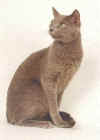
Ch. Eldar Celebros Silme |
Photos Courtesy of Eric
Johnson
Click on picture to enlarge |
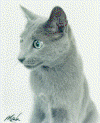
Icon Mithril Aranel of Eldar |
"Breeders of short-haired blues have never been many in number, nor has
there ever appeared any startlingly good specimen in the show pen; Mr. Woodiwiss
kept and exhibited several fine specimens-"Blue Boy", "Blue Lking",
and "Blue Queen". The two latter have been passed on to LadyAlexander.
Mr. Mariner, of Bath, is an old exhibitor and great enthusiast of this breed.
Mrs. Middleton, Mrs. Herring, Mrs. Crowther, Miss Butler, Mrs. Illingworth, and
Mrs. Pownall have all from time to time been possessed by fairly good Russians
so called. Mr. Cole used to show a lovely fat-faced cat called "Muff",
but she had green eyes. Mr. Dewar’s "Firkins" and Mr. McNish’s
"St Juan" are blue that have made their name."
"The three principal breeders at the present time of these cats are Lady
Alexander, Mrs. Michael Hughes, and Mrs. Carew Cox. It is at the Crystal Palace
shows that an opportunity is given of admiring the fine team of blues from the
Faygate cattery. "Brother Bump" has won a first prize whenever he has
appeared in the show pen, and curiously enough, each time under a different
judge. He is a full champion and special prizes have been showered upon him.
Besides this handsome fellow, Lady Alexander owns another male, "Blue
King", and two good females."
"Mrs. Carew Cox is a most ardent supporter and successful breeder of
short-haired blues. As she has had a long and varied experience, I asked her to
send me some notes. I have please in publishing them for the benefit of my
readers:"
"Blue short-haired cats, m any of them imported from northern Russia,
make very desirable pets, presenting, as they do, a neat, smart,
"tailor-built" appearance all the year round, and possessing the great
intelligence usually to be met with in all short-haired breeds. They have the
advantage over many other varieties in that they are, as adults, strong, healthy
cats – not at all liable, as a rule, to pulmonary attacks. Kittens, however,
require both care and patience to rear successfully, and, strange to say, attain
sounder constitutions when brought up by healthy English foster mothers. Females
are more difficult to rear than males. A Russian cat should be of an even shade
of blue throughout, even the skin itself being often, in fact, generally, of a
bluish tinge. There should be no stripes or bars, and, for exhibition purposes,
there should be no white patches. Kittens frequently have body markings when
very young, also rings on their tails, but in purebred specimens these defects
generally become effaced before they are many weeks old. In one cat a kitten
(now a large neuter) had until five months of age two broad black stripes down
his back on either side of his spine. They were so decided in appearance that it
seemed very doubtful that they would ever disappear. However, at six months old
he was a perfectly self-colored cat! This is, of course, most remarkable and
unusual, and amongst all the many kittens of this breed that I have reared for
the past thirteen years there has never been another presenting a similar
appearance."
"The eyes of a Russian should be golden in color, or deep orange. To
procure deep colored eyes, experiments have been made in crossing Russians with
Persians, but the results, so far as I have seen, have not proved satisfactory,
and to an experienced eye the cross is perceptible. I believe there is no really
recognized standard of points for this breed, which until quite recently was
comparatively little known. I note that there is a very fair demand for Russians
at the present time. Chiefly, strange to say, from the North of England. The
shape of the head in many of those imported is more pointed than round. Indeed,
some have long, lean, pointed heads and faces, with big ears. The backs of the
ears should be as free from hair as possible. Some, I remark, are entirely
devoid of hair on the upper parts of their ears, at least, if there is any, it
is not perceptible to the naked eye. Others, again, have ears covered with
peculiarly fine, close, silky hair. (TRADITIONAL TYPE) Some imported blues are
very round in face and head, with tiny ears, and eyes set rather wide apart.
These are surely the prettiest, and are generally given the preference at shows.
But, of course, it cannot be denied that the long-faced variety present the most
foreign appearance, more especially when this type also possesses a lithe and
rather lean body. The whiskers, eye lashes and tip of nose should all be dark
blue."
"The coat should be short and close, glossy, and silvery; sometimes it
is rather wooly and furry, Nature having evidently provided these cats with
their warm, close coats to enable them to resist the severities of their native
climates, short-haired blues existing also in the north of Norway, Iceland, and,
I am told, in some parts of the United States. Many years ago some blues (with
faint tabby markings) were imported from the north of Norway; these were called
‘Canon Girdlestone’s breed". I owned two very pretty soft-looking
creatures. Blue and white cats have been imported from the north of Russia, and
are particularly attractive when evenly marked."
"Some blues are far paler in color than others. Amongst my kittens are
frequently some very beautiful lavender-blues. I have remarked that these are
rather more delicate in constitution than those of darker hue. As these cats
advance in years they frequently become a rusty brown during the summer months,
or when acquiring a fresh coat. This discoloration asserts itself principally at
the joints of legs and feet. The fur of a very old cat becomes dull and rough,
losing the soft and glossy appearance identical with the blue Russian in his
prime."
"There are some peoploe who appear to wish to assert that there is an
English breed of blues, and I have been told strange tales of unexpected
meetings in country villages with cats of this color, whose owners declared that
both parents were English bred. As, however, it is not always possible to
identify the sires of household cats, I venture to doubt these assertions. It is
sometimes possible to breed blues from a black English female mated to a Russian
male. This experiment does not always succeed, as some black never breed blues,
although mated several times consecutively with Russians. A white English female
mated to a blue male simply produces white kittens, at least, this has been my
experience. Cats imported from Archangel are generally of a deep, dirm blue
throughout; the eyes and ears rather larger than those of English cats, the head
and legs longer. In many of the Russian peasants’ cabins can be seen a curious
colored print 9executed in Moscow). It represents the burial of the cat after a
dramatic fashion, and derives its origin from a very interesting Russian legend.
The cat is represented as slate-colored."
|
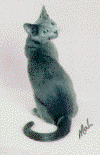
|
QGC Icon Vása Vingilot of Eldar
Photos Courtesy of Eric
Johnson
Click on picture to enlarge |
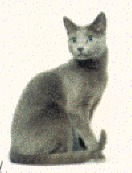
|
"It is often impossible to decide the ultimate color of a kitten’s
eyes until it is four months old. They vary very much, sometimes giving one the
impression that they are green, and perhaps a few days afterwards one discovers
them to be yellow! As these cats become better known, they naturally increase in
popularity, and I should not be surprised to hear of several well-established
kennels of this breed in the immediate future."
"It is many years ago since I first made acquaintance with this breed,
but I find I made no notes at the time, so can not give full particulars. In
1889, however, I purchased a smooth blue, whose owner declared her to be a
Siamese. She certainly resembled a puma shaped Siamese in her body outline and
movements, and I believe I entered her in the stud book as such. "Dwina"
won many prizes at Crystal palace and other shows in "any variety"
classes, was a most faithful creature, reared many families, and lived until
June, 1901. In 1890 I owned a very pretty soft looking blue female. She was, in
fact, a blue tabby (one of Canon Girdleston’s breed-Norway); also a male of
the same variety. They had evidently been the victims of tape-worm for a
considerable period, and finally succumbed owing to the presence of these odious
parasites in overwhelming numbers. That same year "Kola", a very
pretty blue and white female, became mine. She was imported from Kola, and after
changing hands more than once whilst at sea, she was finally exchanged at the
London Docks for a leg of mutton! A very lovable little cat was
"Kola", with very round face and very short fur. (TRADITIONAL TYPE)
She lived until November 1900, and evidently died from old age, becoming feeble
and toothless, but quite able to enjoy the soft food that was specially prepared
for her. These two old pets, "Dwina" and "Kola", were a
great loss, after twelve and ten years’ companionship. "Lingpopo",
an extremely beautiful blue, was imported from Archangel, very sound in color,
rather long in face and legs, sleek, sinuous, and graceful, peculiarly lethargit
in her movements, and dainty in her deportment. I bought her in 1893, when she
was seven months old. Unfortunately, a disease of the kidneys carried her off
when in the flower of her existence. "Moscow" (1893) was a very
successful blue Russian sire of many kittens. He won many first and special
prizes. He died in 1897, during my absence from home. In 1895 Lady Marcus
Beresford presented me with a very handsome kitten, a male, with a very thick
yet close coat, and very compact in shape. "Olgo" came to me in 1893
or 1894, and still lives. She was imported, and has been a great winner in her
time, but is getting an old cat now. She is the mother of my stud cat
"Bayard", who was born in 1898, and whose sire was "King
Vladimier". "Fashoda" was born in 1896, and was imported. She is
a large, strong cat, and a winner of many prizes. "Odessa" is a
daughter of "Fashoda" by "Blue Gown". "Yula" came
to me in 1901, and was imported from Archangel. "Sing Sing" (neuter)
is the cat that as a kitten had the peculiar black stripes down his spine
alluded to previously. He was born on Easter Monday, 1899, a son of "Fashoda"
and "Muchacho". He has two toes off one of his hind feet –the result
of a heavy weight falling upon his foot when a kitten. He suffered greatly from
shock, and every day for three weeks he paid visits to the doctor, who dressed
his foot, having previously amputated the toes. The little fellow had a sad
time, but he does not miss his toes now.:
""Muchacho", the stud cat that has sired so many winning
kittens, is a son of Mrs. Herring’s (late) "Champion Roguey" and my
(late) "Lingpopo". I sold him as a kitten, but after two people had
had him, I again became his owner, and now he will never leave me until he is
called to the "happy hunting grunds" that I hope, and think, must be
prepared for all faithful creatures somewhere "beyond the veil"."
"In America the classification given for these cats at the Beresford Cat
Club show is "Blue or Maltese," but I have not heard of any ardent
fanciers of this breed over the water. More will be written on the so-called
Maltese cat by one well qualified to bive information later on in this
work."
"I have always been told what delightful pets these blues become, being
extremely intelligent and affectionate. Mrs. Bagster, the Cat Club’s Hon.
Secretary, owns a splendid fellow, one of Mrs. Carew Cox’s well-known
strain."
"At the time of writing there is no specialist club for short-haired
blues, but they are included in the list of the British Cat Club, founded by
those ardent supporters of the short-haired breeds, Sir Claud and Lady
Alexander. No standard of points has been drawn up for these cats."
This forms the basis of the Russian Blue’s beginnings in England. We see
the political injustice toward imported cats. At times I felt like I was reading
the very same politics put forth in modern day writings. It appears the cat
world hasn’t learned a tiny bit of respect for breeds or open mindedness
through a period of over 100 years. Further lack of reverence for the Russian
Blue as a pure breed is evidenced in Frances Simpson’s further writing in her
same book…
"For a long time we have called the self blues Russians. No doubt they,
in the first instance, came from the East. But since they were imported into
this country (England) they have been mixed in a great measure with self blacks,
and in some cases with long-haired blues, to get strong, short, round heads
(TRADITIONAL), so that at the present time we have very few pure-bred Russians
in this country."
"My advice to those who are breeding self blues or self blacks is, by
all means put one cross of black in the blues, especially if the black has
orange eyes. It is in eyes that most of our self blues fail. Let me, however,
give here a word of warning. Do not mix the colors too often, or you will get
blues too dark or nearly like black. If you get one cross of the black and blue,
use it as it should by used, by mixing the offspring well together. I know a
great many breeders are not in favor of this in-breeding. This is, without
doubt, their loss. In all branches in-breeding is the sure road to
success." (TCA, Inc. does not approve of in-breeding)
"To go outside at every cross, or too often, brings with it a lot of
trouble and disappointment. To all my advice is, having got the strains of noted
sires in your youngsters, so mix them that all the good and little of the bad
points will come out as the results of your breeding. That you will not get all
winners is a sure conslusion, but my experience is, and it is formed after
thirty years’ breeding of fancy pet stock, that in this way you are more
likely than in any other to breed winners. Anyone who has seen Lady Alexander’s
"Brother Bump" (British Shorthair), Mrs. Hughes’ "Alexis"
(British Shorthair), Miss Butler Ayton’s "Blue Bell" and "Blue
Stockings" (British Shorthairs), Mrs. Carew Cox’s "Fashoda"
(Traditional Russian Blue) and Mrs. Dewar’s "Firkens’" (British
Shorthair) can not but fall in love with this color. All that is needed to make
this one of our most popular varieties is uniformity in shape. In my opinion
these cats should be judged on the same lines as our self black and self
whites."
The British obviously were focused on color not body shape or type at all.
This resulted in the miss mash described above of the British Shorthair and
Traditional Russian Blues being bred together for color. This resulted in no
predictability of type, which to me seems to have taken both breeds in the wrong
direction.
Since the round-headed, cobby British Blues were favored at that time, the
Traditional Russian Blue rarely won. Interest in the breed waned.
In 1912 the GCCF finally gave the breed long past due recognition and the
Traditional Russian Blue was given a show class of its own. A little progress
with the breed was made until the bombing of Great Britain during World War II
almost made the breed extinct.
To rebuild the breed from the ashes of war meant crossbreeding the few hardy
survivors with other breeds during the 1940s and 1950s. The British used
Traditional Russian Blues and crossed them with Blue Point Siamese and Blue
British Shorthairs. Because of the "Siamese" influence, which had
already been taken to extremes by then, the Traditional Russian Blue became far
too extreme, elongated, delicate boned and light in type. In keeping with
changing breeds the GCCF rewrote the Breed Standard accordingly in 1952. One of
the hall marks of the breed, its thick, double coat, was eliminated. The breed
was not longer what it had been.
Meanwhile, and over the same time frame, Scandinavian breeders in Sweden,
Finland and Denmark attempted to recreated the breed as well, by crossing Finish
blue cats with Siamese cats in an effort to enhance the solid blue coloration.
The results were Traditional type Russian Blues, which were much larger than the
British version, with larger heads, and shorter, denser coats.
These separate efforts blurred the overall type of the breed even more.
Consistency had vanished.
Displeased with all this maneuvering of the breed, a group of British
breeders began in 1965 to restore the Traditional Russian Blue to its original
state. Once again in 1966 the British re-wrote the Breed Standard changing the
breed once more. Now the "Siamese type" was undesirable. The
Scandinavian type and the British type were bred together, finally achieving
some degree of uniformity.
Some where along this road of change, mix in other breeds, change, out-cross,
and change again, their eye color was changed from deep orange or amber to
green. Go figure!
As stated earlier the Traditional Russian Blue arrived in American in the
early 1900s. Not until 1947 did the breed capture serious breeders attempting to
promote it in the U.S. Once again a lack of uniformity and competition with the
other "blue breeds" pushed the Traditional Russian Blue to the back
burner. The first Traditional Russian Blues Registered appeared in the CFA Stud
Book, Volume 34, in 1949. These were the imported "Dunloe Jan" and
"Dunloe Blue Silk". They were litter mates out of "Dunloe
Aphrodite" and sired by "Dunloe Blue Socks". The first U.S. Grand
Champion received the honor in 1964. This was the male, "GrCh. Maja Acre
Igor II or 3 R’s".
More imports from Britain stabilized to some degree the type problem to the
point where breeding stock was exported from America to Europe to improve their
bloodlines there.
Early on in the U.S. the following catteries were working with Traditional
Russian Blues: Bobcat Cattery in Texas, Three Crown Cattery in New Jersey,
Aberdeen Cattery in Alabama, Felinest Cattery in Illinois and a few in
California. Certain Traditional Russian Blues rose to the top in the breed and
became the famous cats that are behind most of the Traditional Russian Blues
bred today. Among them were: GC Felinest Silver Dollar, GC Es-Ta’s Tao of
Aberdeen, GC Pavel of Braheborg (Imp.) and GC Tinnerdalen Njusia of Bobcat.
The combination of several bloodlines resulted in the first Traditional
Russian Blue who was campaigned on a national basis. This was GC Kit-Kin Peter
of Car-Mac, who became CFA’s best Traditional Russian Blue in 1968 and 1969.
Another cat worthy of mention was GC Meri-Rose Mischa of Evinrude, the 1970 Best
Traditional Russian Blue. Even though these two cats were considered excellent
during the time they were shown, it was the male, GC Felinest Flying High of
Velva, who established the too extreme, to thin, to delicate type of today. Of
course, both he and his offspring received high awards, as the other cat
associations pushed extremism.
The breed has two outstanding features. One is its beautiful, thick, double
coat. It is so dense that it stands out from the body. It is possible to use
your fingers to trace designs in the fur. The patterns remain until smoothed
over or until the Traditional Russian Blue tires of the game and walks away,
re-setting its fur back to its natural state. The second dominant attribute is
its solid blue color. In the cat world this is actually gray. Silver tipped
guard hairs reflect light, providing the over all shimmering, silver sheen. This
is a strikingly beautiful, captivating, and artistically satisfying cat. It
certainly is a Rhapsody in Blue.
PERSONALITY
Devoted, affectionate, quiet, shy, reserved, clean, playful, interesting,
composed, entertaining, and intelligent the Traditional Russian Blue is
incredibly enchanting. Always gentle, loving, and considerate, they display a
sort of perpetual smile for their favorite people. Their voice is soft and
sweet. They make delightful pets and loving companions with an unassuming yet
appealing nature. Sensitive to the moods of their home, they have been known to
"clown" to quiet a crying baby or sit on their people patting your
face to chase the blues away. They get along well with other pets and children.
Clever and agile, they can learn to open doors, sit on top of doors and get
into small spaces.
You may purchase a Traditional Russian Blue, but the cat will determine how
the relationship will progress. Once their trust in won, they reward their
people with complete devotion and will react to you as they will to no other
person. In other words they select you. Kittens are usually not out going,
preferring, instead, to run to safe quarters, there to review new developments.
At this point, if you wish to establish a relationship, sit down, quietly use a
cat toy and wait. The kitten will immerge and play. From that point on
negotiations for a more serious relationship begin. The kitten will then
determine just how interested you are in getting to know him. This is a game of
"wait and see", which needs patience on your part. The kitten is
seeking a totally committed new owner, who will provide individual attention.
They don’t like change or loud music. They are easily startled and prefer
delicate handling. They don’t do well in households with large numbers of
cats. Instead, meals on time, an ordered existence, lots of toys to play with,
and treatment as a valued member of the family are required.
Because of their undemanding nature they fit well into today’s busy
schedules. They easily entertain themselves when home alone and can be counted
on to be a contented companion when their owners return. Only a minimum of
grooming with nail clipping can keep their goats looking good. Frequent petting
and occasional brushing is always welcome because it allows them additional
attention and time with their family.
HEALTH
Strong, hardy, long-lived and healthy.
HISTORICAL RECORD © March
2002
Diana Fineran
|
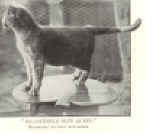
|
Click on photo to enlarge |
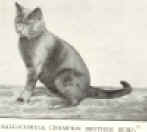
|
These 1902 pictures are important because they present the
Traditional Russian Blue as it original was and as TCA, INC. recognizes it
today.
|
|
|
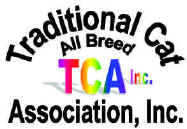
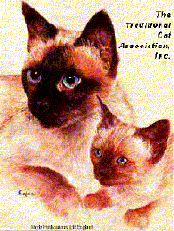 The
Traditional Cat Association,
Inc.©1987®TM
Official Website
The
Traditional Cat Association,
Inc.©1987®TM
Official Website







